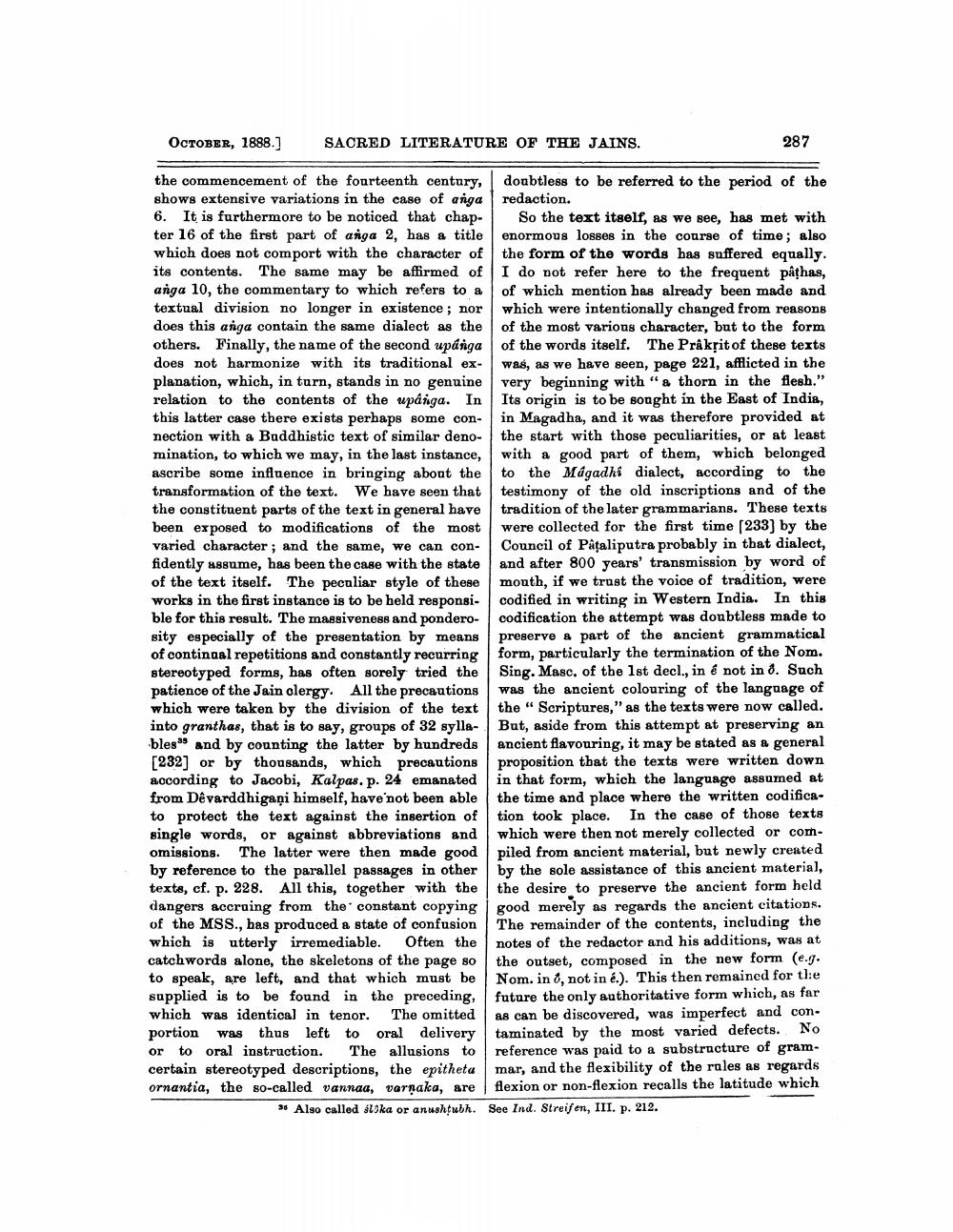________________
OCTOBER, 1888.)
SACRED LITERATURE OF THE JAINS.
287
the commencement of the fourteenth century, doubtless to be referred to the period of the shows extensive variations in the case of anga | redaction. 6. It is furthermore to be noticed that chap- So the text itself, as we see, has met with ter 16 of the first part of anga 2, has a title enormous losses in the course of time; also which does not comport with the character of the form of the words has suffered equally. its contents. The same may be affirmed of I do not refer here to the frequent pathas, anga 10, the commentary to which refers to a l of which mention has already been made and textual division no longer in existence; nor which were intentionally changed from reasons does this anga contain the same dialect as the of the most various character, but to the form others. Finally, the name of the second upanga of the words itself. The Prákřit of these texts does not harmonize with its traditional ex- was, as we have seen, page 221, afflicted in the planation, which, in turn, stands in no genuine very beginning with "a thorn in the flesh." relation to the contents of the upanga. In Its origin is to be sought in the East of India, this latter case there exists perhaps some con- in Magadha, and it was therefore provided at nection with a Buddhistic text of similar deno- the start with those peculiarities, or at least mination, to which we may, in the last instance, with a good part of them, which belonged ascribe some influence in bringing about the to the Mágadhi dialect, according to the transformation of the text. We have seen that testimony of the old inscriptions and of the the constituent parts of the text in general have | tradition of the later grammarians. These texts been exposed to modifications of the most were collected for the first time (233) by the varied character; and the same, we can con- Council of Pataliputra probably in that dialect, fidently assume, has been the case with the state and after 800 years' transmission by word of of the text itself. The peculiar style of these mouth, if we trust the voice of tradition, were works in the first instance is to be held responsi- codified in writing in Western India. In this ble for this result. The massiveness and pondero- codification the attempt was doubtless made to sity especially of the presentation by means preserve a part of the ancient grammatical of continual repetitions and constantly recurring form, particularly the termination of the Nom. stereotyped forms, has often sorely tried the Sing. Masc, of the 1st decl., in é not in 8. Such patience of the Jain clergy. All the precautions was the ancient colouring of the language of which were taken by the division of the text the " Scriptures," as the texts were now called. into granthas, that is to say, groups of 32 sylla- But, aside from this attempt at preserving an bles" and by counting the latter by hundreds ancient flavouring, it may be stated as a general [232] or by thousands, which precautions proposition that the texts were written down according to Jacobi, Kalpas. p. 24 emanated in that form, which the language assumed at from Dêvarddhigaội himself, have not been able the time and place where the written codificato protect the text against the insertion of tion took place. In the case of those texts single words, or against abbreviations and which were then not merely collected or comomissions. The latter were then made good piled from ancient material, but newly created by reference to the parallel passages in other by the sole assistance of this ancient material, texte, cf. p. 228. All this, together with the the desire to preserve the ancient form held dangers accroing from the constant copying good merely as regards the ancient citations. of the MSS., has produced a state of confusion The remainder of the contents, including the which is utterly irremediable. Often the notes of the redactor and his additions, was at catchwords alone, the skeletons of the page so the outset, composed in the new form (e.g. to speak, are left, and that which must be Nom. in 8, not in é.). This then remained for the supplied is to be found in the preceding, future the only authoritative form which, as far which was identical in tenor. The omitted as can be discovered, was imperfect and conportion was thus left to oral delivery taminated by the most varied defects. No or to oral instruction. The allusions to reference was paid to a substructure of gramcertain stereotyped descriptions, the epitheta mar, and the flexibility of the rules as regards ornantia, the so-called vannaa, varnaka, are flexion or non-flexion recalls the latitude which
* Also called sloka or anushţubh. See Ind. Streifen, III. p. 212.




